Address any questions or comments regarding this newsletter to the individual authors listed after each article or to its editors, Nathan Johanning, 618-939-3434, njohann@illinois.edu or Bronwyn Aly 618-695-6060, baly@illinois.edu. The Illinois Fruit and Vegetable News is available on the web at: http://ipm.illinois.edu/ifvn/. To receive or be removed from email notification of new postings of this newsletter, contact Nathan Johanning or Bronwyn Aly at the phone numbers or email addresses above.
In This Issue:
Upcoming Programs (listings for beginning and established growers)
News and Announcements (Midwest Mechanical Weed Control Field Day)
Regional Reports (northern, St. Louis metro east, southern Illinois, Dixon Springs)
Fruit and Vegetable Production and Pest Management (Corn Earworm Management in Sweet Corn, Tomatoes, Peppers; Cross-striped Cabbage Worm and Harlequin Bug on Brussels Sprouts, Broccoli, and Cauliflower, Late-season Pumpkin Insect Control, Late-season Stink Bug Control in Apples)
Upcoming Programs
Check the Illinois SARE calendar for a full list of programs and links for registration.
http://illinoissare.org/ and http://illinoissare.org/calendar.php
Also see the University of Illinois Extension Local Food Systems and Small Farms Team's website at:
http://web.extension.illinois.edu/smallfarm/ and the calendar of events at http://web.extension.illinois.edu/units/calendar.cfm?UnitID=629.
- Midwest Mechanical Weed Control Field Day Wednesday September 26, 2018 PrariErth farm in Atlanta, Illinois. Visit https://thelandconnection.org/farmers/mechanical-weed-control-field-day-2018 for more details and information about the field day as time gets closer.
News and Announcements
2nd Annual Midwest Mechanical Weed Control Field Day Comes to Central Illinois!
A full day of exhibitors, in-row demonstrations, farmers and industry experts!
The Midwest Mechanical Weed Control Field Day is the Midwest's largest field day devoted
to vegetable growers and mechanical weed control. This year's Midwest Mechanical Weed Control Field Day takes place on Wednesday, September 26 at PrairiErth Farm in Atlanta, IL. Hans Bishop, co-owner of PrairiErth Farm, will be hosting the event in the farm's new packing shed, which also serves as a local Food Hub and Educational Center. The event is being planned by Sam Hitchcock Tilton, an organizer of last year's event and Midwest representative for KULT-Kress precision weeding tools, and The Land Connection, an Illinois non-profit organization that promotes farmer training and land stewardship.
The field day is an ideal opportunity for farmers to learn about weeding tools and techniques. In the morning soil health expert Alan Philo (formerly the specialty crop specialist for Midwestern BioAg) will give a presentation on cultivation methods that preserve soil health and soil-building techniques that allow for subsequent precision cultivation. The exhibition period that follows is an opportunity for growers to see weeding tools from more than 10 companies and speak with representatives. University weed scientists from surrounding states will share their research, Midwest farmers will exhibit their favorite weeding tools, and 'Walk-Behind Alley' tent will feature two-wheeled walk-behind tractors and implements. In the afternoon, Myriad cultivators and cultivating tractors will be demonstrated in the field on direct-seeded beets and transplanted lettuce. These demonstrations will show how the machines should be mounted and properly adjusted, and will help farmers visualize how the implements can work on their own farms to increase efficiency and productivity.
All currently-manufactured cultivating tractors will be attending (Tilmor, Oggun, and Tuff-Bilt) as well as many others (IH-274, Hefty G, IH Super C, and modified Allis G's). Field demonstrations will include a tine-weeder, belly-mounted finger-weeders, rear-mounted steerable toolbar, basket weeder, a mechanical transplanter, and a camera-guided in-row robotic cultivator. Numerous additional tools will be in the exhibition area, such as a Lilliston rolling cultivator, William's toolbar system, Reigi/Eco weeder, and propane flame weeder. The field day costs $20 and includes breakfast, lunch, and root beer floats at the end of the day. Register online: https://thelandconnection.org/farmers/mechanical-weed-control-field-day-2018.
If you would like more information please contact Mallory Krieger at mallory@thelandconnection.org or by phone (312) 840-2128.
Regional Reports
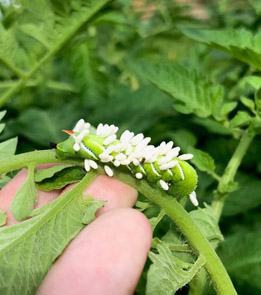
Photo. G. McCarty
From northern Illinois...Orchards in Northern Illinois have just opened for the season. Zestar, Gingergold, Early Beauty, and Gala (some) have been picked in the last week with more varieties to come. We are still getting a regular rain shower each week. At our Rockford office, I recorded 3 inches overnight on 8/28. We have two peach trees in our Winnebago County office and both of them have done well for us this season. We started harvesting the peaches last week with most of it being donated to the food pantry. I did see some Oriental Fruit Moth damage this year and will work to address it next year. Cover crops are on the mind of a lot of folks and as we know, the options begin to decrease as we get closer to the frost in mid-October. Radish can work well but you may find that you do not have enough weeks for establishment. I still like Rye and Wheat as good cover crops. We just had the Midwest Garlic Festival in Elizabeth with a number of growers in the Midwest coming to this event. This was the perfect time to stock up on unique garlic varieties to plant the end of September. It's held every year the start of August so plan to make the trek next year if you haven't been. Yesterday, I was at a farm in Orangeville and saw a tomato hornworm with parasitoid wasp eggs on it. You don't see this too often.
Grant McCarty (815-235-4125; gmccarty@illinois.edu)
From St. Louis Metro East... Planting of annual strawberries on plastic has started. Growers are reminded to keep anthracnose fruit rot (AFR) on their radar. Serious losses can occur with this disease if it builds up under covers over winter. The most common sources are the transplants themselves or infected soil from previous plantings. Continue to scout new plantings for any signs of developing lesions on any part of the plant. There are three species of Colletotrichum associated with the strawberry diseases referred to as anthracnose. Leaf spots caused by C. acutatum are brown to black and often more numerous along leaf tips and margins. The spots differ somewhat from the randomly distributed gray to black spots caused by C. fragariae or C. gloeosporioides. If the anthracnose fruit rot pathogen has been positively identified in newly established plants, apply a strobilurin (such as Quadris or Cabrio), before colder temperatures in late fall to protect the plants from colonization. This treatment can potentially prevent the establishment of an epidemic in anthracnose susceptible varieties including Chandler, Camarosa and Albion. Sweet Charlie so far shows good resistance. North Carolina State Extension has noted resistance to FRAC 11 fungicides (Pristine, Cabrio, Merivon, Abound) having been found in Florida and California and is strongly recommending that the FRAC 11 fungicides be used only in mixture at the low label rate with the medium labeled rate of captan products alternated with captan alone. North Carolina State Extension has also recently documented reduced activity with azoxystrobin (Abound, Azaka) with certain strains of the anthracnose fruit rot pathogen. Cabrio, Merivon, or Pristine have offered better control of AFR in their recent research efforts.
Peach harvest has for the most part come to a close. Laurel, Encore, PF-35 and Autumn Star just finished and were the last for most growers. A few growers with really late peaches like Parade will be finishing soon. Gala (apple) harvest has finished and has moved on to Honeycrisp, Blondee, Early Fuji, and in a few locations, Jonathan.
Many vegetables are still in harvest as reported in the last newsletter. What's new is winter squash, gourds and pumpkins. The crop looks good and harvest has started, though the "Halloween" market won't ramp up for a few weeks yet.
Elizabeth Wahle (618-344-4230; wahle@illinois.edu)
From southern Illinois... All is slowly drying out after the remnants of Hurricane Gordon, it southern Illinois late Friday into Saturday morning. Rainfall totals varied, Murphysboro 5.0", southern Monroe County at the family farm 5.5", and other reports of as much as 9" in northern Randolph County all of which fell mostly overnight Friday into early Saturday morning. With the rain also came a cold front which kept our weekend temperatures cool over the weekend barely getting to 70°. Prior to this front, we were in a very humid and stick air mass with temperatures around 90°. This week is supposed to be very pleasant, dry and mainly sunny with highs in the 80s.
Out in the orchard peach harvest is winding down and apples are picking up. Many are now getting into Jonathan and some goldens.
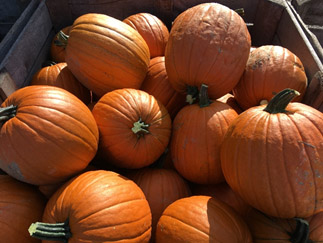
Pumpkins harvested from a no-till, wheat stubble
pumpkin field 1 day after a 5" rain. Photo: N. Johanning
In the field pumpkin harvest has now started. Pumpkins are looking good overall. We have observed fairly low powdery mildew pressure in many fields. With fairly frequent rains bacterial spot has been a concern for some growers, but nothing wide spread. The rain has shown the benefit of no-till and cover crops. I harvested pumpkins at home less than 24 hours after over 5" of rain and was able to drive tractors with minimal mud and walk through the field with clean boots, harvesting fairly clean pumpkins. Some would have a little soil on them especially if they were laying over the transplanter row, but most were very clean. I really appreciate this growing system when I consider the thought of mud up to my ankles, having to wash all of the pumpkins and/or getting tractors stuck. To me the added labor an time those thing could add more than justifies this system, beyond all of the other benefits.
Thanks to all who came out to Pumpkin Field Day last week at the Ewing Demonstration Center. We had close to 90 in attendance from all over Illinois, and Missouri, Indiana, and Kentucky. Be looking for more data on information from the trials later this year and at winter meetings.

Pumpkin Field Day Weed Management presentation. Photo: H. Willis
Nathan Johanning (618-939-3434; njohann@illinois.edu)
From Dixon Springs Ag Center...Now that data collection for the cucumber variety trial in the hydroponic tunnel has come to an end, we have been increasing fertilizer to the indeterminate tomatoes and strawberries. Also, with the cooler weather of the last several days, we have adjusted the amount of water being delivered each day. With this combination, we have noticed a positive response in both crops, seeing better quality fruit and improved plant health and vigor. It is interesting to seeing the different growth habits of the different indeterminate tomato varieties. Torero has very compact spacing both between leaves and flower clusters, while Chef's Choice has more space between the leaves and fruit clusters (see photos below). With cooler temperatures, the lettuce table has been set back up with several different varieties. A late planting of roma tomatoes has been set out in the in ground tunnel along with green beans, peas, carrots, and radishes. Cut flowers, peppers, and tomatoes from the initial planting are still going strong.
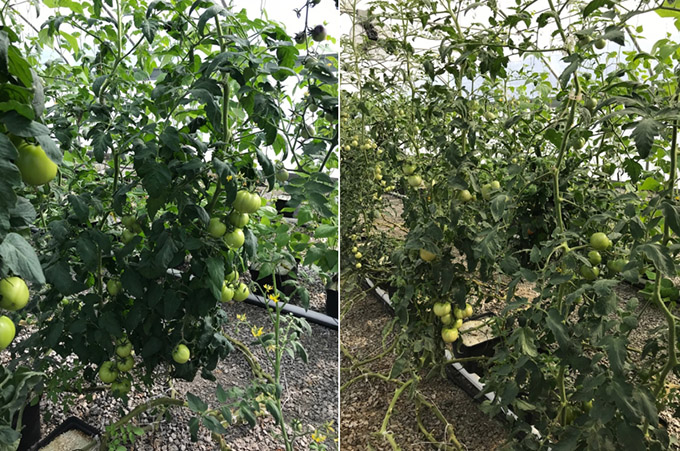
Torero (left) with a very compact leaf and cluster spacing compared to Chef's Choice (right) which has a more spread out growth habit. Photos by B. Aly.
Bronwyn Aly (618-382-2662; baly@illinois.edu)
Fruit and Vegetable Production and Pest Management
Corn Earworm Management in Sweet Corn, Tomatoes, and Peppers
I included some brief notes on controlling corn earworm and other caterpillar pest of tomatoes and peppers a few weeks ago, and earlier in the summer I had provided a detailed summary of management recommendations for corn earworm in sweet corn. None of those recommendations has changed, but the time of year has. Three factors point to the need to continue to control this insect in susceptible crops: (1) A moderate to heavy corn earworm moth flight appears to be underway in at least multiple widespread locations in Illinois and one or more adjacent states ... egg-laying will give rise to larvae that will enter sweet corn ears, peppers, tomatoes, and other crops; (2) vegetable crops are still green and attractive to corn earworm moths ready to lay eggs – corn and soybeans are not, so a very high portion of egg-laying is concentrated in late vegetable crops; (3) sprayer fatigue – you're tired of making regular sprays all season and hoping to quit – that's ok if you're planning to stop harvesting in a few days, but otherwise it's not. The 2018 Midwest Vegetable Production Guide lists insecticides that are effective for control of corn earworm. In general, weekly applications of pyrethroids (primarily Baythroid, Brigade, Mustang Maxx, or Warrior – or a generic version of one of these) OR Coragen, Radiant, or another alternative works well enough in tomatoes and peppers. Alternating a pyrethroid and an alternative compound is a good idea. In sweet corn, using one of the pyrethroids listed above PLUS Coragen, Radiant, or Lannate on a 2- to 3-day interval from first silk to 3-5 days before harvest is recommended for effective earworm control at this time of year.
Cross-striped Cabbage Worm and Harlequin Bug on Brussels Sprouts, Broccoli, and Cauliflower

Left: Cross-striped cabbageworm (image from Purdue University, Extension Entomology). Right: Harlequin bug (image from University of Maryland Extension).
From spring through late fall, three very common caterpillars feed on leaves and heads of plants in the cabbage family; they are imported cabbageworm, diamondback moth, and cabbage looper, and I've covered their life cycles and control earlier in the season. In late summer and fall, two additional species show up on these crops – cross-striped cabbageworm and harlequin bug. I've seen both at multiple locations in the last couple of weeks. Cross-striped cabbageworm feeds on leaves and in heads of cabbage family plants, reducing yields and marketability. Because moths of this species lay eggs in clumps or masses, worms and damage may be heavy on an individual plant and completely absent a few plants away. The same insecticides used to control other "worms" in these crops (Bt against young larvae, Coragen, Radiant, and pyrethroids) are also effective against cross-striped cabbageworm. Harlequin bugs are brightly colored stink bugs that feed by inserting a needle-like stylet into plants and sucking out plant fluids. Leaves show white spots or stipples at feeding sites, and developing shoots or heads can be disformed by harlequin bug feeding. Pyrethroid insecticides and the neonicotinoids Actara, Admire-Pro, and Belay (and generic products with the same active ingredients) are effective against harlequin bugs. See the 2018 Midwest Vegetable Production Guide for a more complete listing of insecticides by crop; be sure to obey pre-harvest intervals where harvests are coming up or ongoing.
Late-season Pumpkin Insect Control
Most pumpkin insect problems subside in September and early October prior to pumpkin harvest, but squash bugs, cucumber beetles and corn rootworm beetles, and aphids may persist and warrant control.
Squash bugs may continue to feed on vines and directly on pumpkin fruits. As vines die down, nymphs and adults feeding directly on fruits and "handles" can cause shriveling and distortion and produce wounds that allow entry of fruit rotting pathogens. Where fruit-feeding is occurring, pyrethroids such as Brigade, Warrior, or Mustang Max are effective for control.
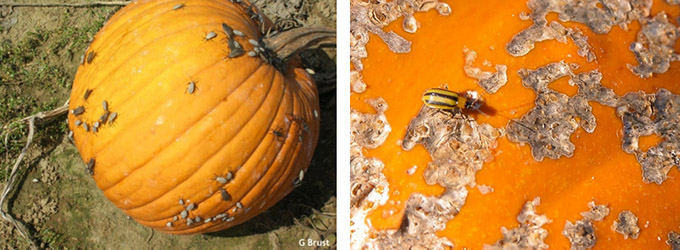
Left: Squash bugs on ripening pumpkin. Right: Cucumber beetle and feeding damage on pumpkin. (Photos from Ohio State University Veg Net.)
Spotted cucumber beetles, striped cucumber beetles, and western and northern corn rootworm beetles also feed directly on fruits, scarring the surface, making the fruit unmarketable. Their feeding sites also provide entry for fruit-rotting pathogens. The pyrethroids listed above (Brigade, Warrior, and Mustang Max), products that contain the pyrethroid permethrin (Pounce and generics), and Sevin XLR Plus are among the most effective insecticides labeled for control of these beetles on pumpkins.
As vines die down, aphid colonies move to pumpkin fruits, often around the handle and where the fruit rests on the soil. Their feeding may result in sunken areas on the fruit, and their presence, along with the honeydew they secrete, may reduce the crop's marketability. Aphid outbreaks often occur where a pyrethroid or Sevin XLR Plus has been used repeatedly through the season, killing lady beetles and other natural enemies that prey on aphids and limit their populations. Where aphid control is necessary at the end of the season, Assail, Fulfill, Beleaf, or M-Pede (or another insecticidal soap) can be used effectively. M-Pede is labeled for use in organic production; very thorough coverage is required for it to be effective. Actara and Admire Pro are also effective aphicides, but they are especially toxic to bees, so if any late flowering is still ongoing or if there are flowering weeds in the field, they should not be used.
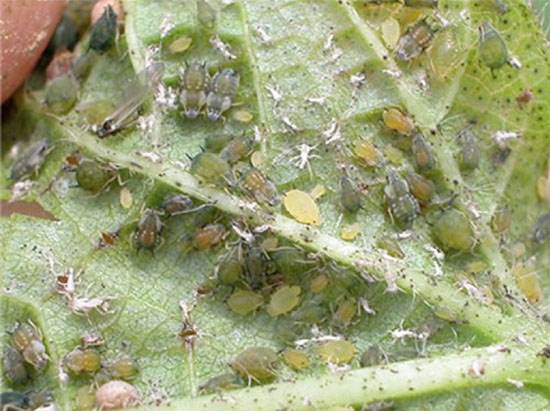
Cotton-melon aphids on pumpkin leaf.
Late-season Stink Bug Control in Apples
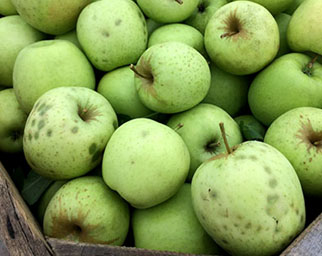
Stink bug damage to apples. (Photo from Michigan State University.)
As corn and soybean fields continue to dry down and reach harvest, stink bugs move from these crops into orchards and vegetable crops. Along with the invasive brown marmorated stink bug, native green and brown species also feed on and damage apples. Most of the insecticides used in cover sprays for control of codling moth (Altacor, Assail, Delegate, Exirel, and Rimon) are not very effective for stink bug control. Insecticides that are more effective for stink bug control include (with preharvest intervals in parentheses after each) Actara (14 days), Baythroid (7 days), Belay (7 days), Danitol (14 days), Mustang Maxx (14 days), and Warrior (21 days). See the 2018 Midwest Fruit Pest Management Guide for rates and other restrictions.
Contributions from Weinzierl Fruit and Consulting, LLC are provided through support by the Illinois Specialty Growers Association. Visit www.specialtygrowers.org for more information or to join the association.
Rick Weinzierl, Weinzierl Fruit and Consulting, LLC (217-621-4957; raweinzierl@gmail.com)
Less Seriously...
http://www.allcleanhumor.com/jokesarchive/arc20.shtml
Marketing Mistakes
Thursday, December 13, 2001
ON TESCO'S TIRIMISU DESSERT: Do not turn upside down. (Printed on the bottom of the box.)
ON BREAD PUDDING: Product will be hot after heating
ON PACKAGING FOR AN IRON: Do not iron clothes on body
ON CHILDREN'S COUGH MEDICINE: Do not drive car or operate machinery
ON NYTOL (A SLEEP AID): Warning: May cause drowsiness
ON A KITCHEN KNIFE: Warning: Keep out of children
ON A STRING OF CHRISTMAS LIGHTS: For indoor or outdoor use only.
ON SAINSBURY'S PEANUTS: Warning: Contains peanuts
ON AN AMERICAN AIRLINES PACKET OF NUTS: Instructions: Open packet, eat nuts.
ON A CHAINSAW: Do not attempt to stop chain with your hands
University of Illinois Extension Specialists in Fruit and Vegetable Production & Pest Management
Extension Educators – Local Food Systems and Small Farms |
||
Bronwyn Aly, Gallatin, Hamilton, Hardin, Pope, Saline, and White counties |
618-382-2662 |
|
Katie Bell, Franklin, Jackson, Perry, Randolph, & Williamson counties |
618-687-1727 |
|
Sarah Farley, Lake & McHenry counties |
847-223-8627 |
|
Nick Frillman, Woodford, Livingston, & McLean counties |
309-663-8306 |
|
Laurie George, Bond, Clinton, Jefferson, Marion, & Washington counties |
618-548-1446 |
|
Zachary Grant, Cook County | 708-679-6889 | |
Doug Gucker, DeWitt, Macon, and Piatt counties |
217-877-6042 |
|
Erin Harper, Champaign, Ford, Iroquois, and Vermillion counties |
217-333-7672 |
|
Grace Margherio, Jackie Joyner-Kersee Center, St. Clair County |
217-244-3547 |
|
Grant McCarty, Jo Daviess, Stephenson, and Winnebago counties |
815-235-4125 |
|
Katie Parker, Adams, Brown, Hancock, Pike and Schuyler counties |
217-223-8380 |
|
Kathryn Pereira, Cook County |
773-233-2900 |
|
James Theuri, Grundy, Kankakee, and Will counties |
815-933-8337 |
|
Extension Educators – Horticulture |
||
Chris Enroth, Henderson, Knox, McDonough, and Warren counties |
309-837-3939 |
|
Richard Hentschel, DuPage, Kane, and Kendall counties |
630-584-6166 |
|
Andrew Holsinger, Christian, Jersey, Macoupin, & Montgomery counties |
217-532-3941 |
|
Extension Educators - Commercial Agriculture |
||
Elizabeth Wahle, Fruit & Vegetable Production |
618-344-4230 |
|
Nathan Johanning, Madison, Monroe & St. Clair counties |
618-939-3434 |
|
Campus-based Extension Specialists |
||
Kacie Athey, Entomology |
217-244-9916 |
|
Mohammad Babadoost, Plant Pathology |
217-333-1523 |
|